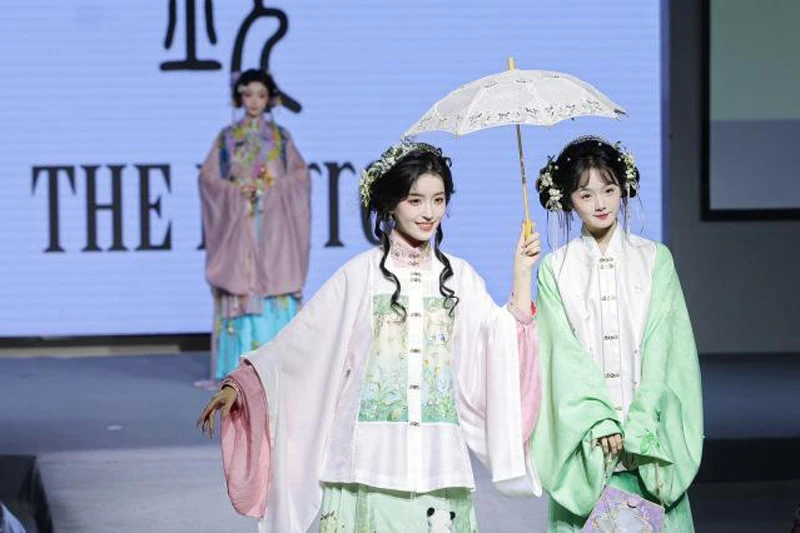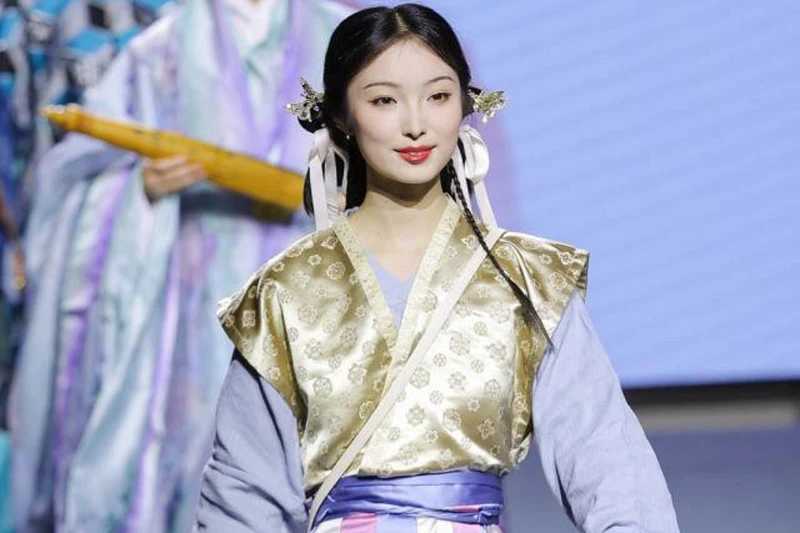In a harmonious blend of ancient elegance and contemporary flair, the 2024 “National Hanfu Festival” recently unfolded at the China Silk Museum. This thematic celebration aimed to showcase the rich heritage of Hanfu culture while infusing it with innovative elements, breathing new life into traditional artifacts.
Since its inception in 2018, the “National Hanfu Festival” has become an annual tradition, now in its seventh consecutive year. In 2022, the festival transcended China’s borders, captivating audiences with a dual-city event spanning Hangzhou and Paris. The 2023 “Hangzhou-Palmyra” Hanfu Festival continued this trend, delighting local residents with a cultural feast. This year, the festival collaborates with Germany’s Marburg and Dusseldorf, fostering cross-cultural exchanges. Hanfu enthusiasts from different regions of Germany will participate in workshops, Hanfu displays, tea ceremonies, and qin (ancient Chinese zither) recitals, collectively celebrating China’s traditional culture.
Within the China Silk Museum, visitors can embark on an immersive journey through the “Silk Road Adventure.” This interactive experience allows them to assume the role of Silk Road explorers, engaging with non-player characters (NPCs) in a fantastical adventure. Along the way, they delve into the historical and cultural significance of the Silk Road.
Two remarkable exhibitions further enrich the festival experience. The “Recovered Textiles from the Ming Dynasty Tomb at Puyuan Yangjiaqiao, Tongxiang” showcases restored fabrics unearthed from ancient graves, revealing the artistry and craftsmanship of the past. Meanwhile, the “Special Exhibition of Ritual and Music Attire from the Kong Family Mansion” narrates stories of China’s traditional attire.
During the “Hanfu Night,” Ms. Ji Xiaofen, Director of the China Silk Museum, issued a compelling call to action: “Embrace Hanfu in your daily life and savor the fusion of ancient elegance and modern hanfu trends.” She views Hanfu as an artistic essence of China’s outstanding traditional culture, reflecting the unique aesthetic sensibilities and national identity of the Chinese people. In today’s dynamic and innovative lifestyle landscape, the “Fashion Revolution” surrounding Hanfu opens up boundless possibilities for its wearability, styling, expression, and aesthetic evolution. Ms. Ji announced that the China Silk Museum will inaugurate the inaugural “Fashion Gala” in October, aiming to seamlessly integrate Hanfu into modern life and position Chinese traditional attire as a global fashion trendsetter.
The “Fashion Gala” scheduled for October promises to be a groundbreaking event, bridging the gap between tradition and contemporary allure. As Hanfu enthusiasts eagerly anticipate this occasion, let’s explore how this ancient attire has seamlessly woven itself into the fabric of modern life.
Everyday Elegance:
The “衣尚革命” (Fashion Revolution) advocated by Ms. Ji Xiaofen encourages individuals to incorporate Hanfu into their daily routines. No longer confined to special occasions or historical reenactments, Hanfu now graces streets, workplaces, and social gatherings. Its flowing silhouettes, intricate embroidery, and vibrant colors evoke a sense of grace and refinement.
Imagine strolling through a bustling metropolis, the gentle swish of silk against your skin, and the admiring glances of passersby. Hanfu enthusiasts embrace this fusion of past and present, celebrating their cultural heritage with pride.
Adaptability and Creativity:
The “生活汉服” (Hanfu in daily life) movement champions versatility. Hanfu wearers experiment with layering, mix-and-match, and personalized styling. A traditional robe becomes a canvas for self-expression, allowing wearers to infuse their unique personality into each ensemble.
From casual outings to formal events, Hanfu adapts effortlessly. A modern twist on the classic qipao or a fusion of elements from different dynasties—these creative adaptations breathe new life into ancient designs.
Social Media Influence:
Social media platforms have become virtual runways for Hanfu enthusiasts. Instagram, TikTok, and Weibo showcase diverse styles, tutorials, and fashion challenges. Influencers share their #HanfuOOTD (Outfit of the Day), inspiring a global community.
Hashtags like #汉服穿搭 (Hanfu Styling) and #HanfuAesthetic trend across platforms, fostering dialogue and encouraging cross-cultural exchanges. Hanfu transcends borders, uniting enthusiasts worldwide.
Bridging Generations:
Hanfu bridges generational gaps. Young and old alike appreciate its timeless allure. Grandparents reminisce about their ancestors’ attire, while teenagers embrace Hanfu as a form of cultural pride.
Family photoshoots featuring multiple generations in coordinated Hanfu outfits capture the essence of heritage and continuity.
Educational Initiatives:
Schools and universities now integrate Hanfu into cultural education. Students participate in workshops, learn about historical context, and even create their own Hanfu pieces.
By fostering an appreciation for traditional attire, educational institutions contribute to the preservation of cultural identity.
In conclusion, the 2024 “National Hanfu Festival” not only celebrates the past but also propels Hanfu into the future. As we witness this harmonious blend of “古韵” (ancient charm) and “今风” (modern trends), let us embrace Hanfu as a living legacy—one that continues to inspire, captivate, and evolve.


